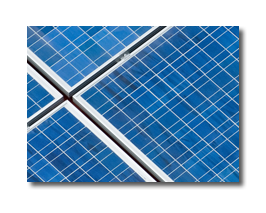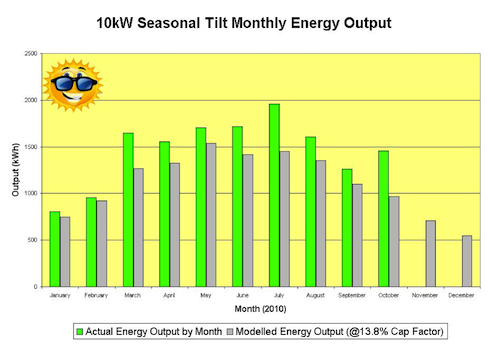 Solar and other renewable energy projects are going strong all over Ontario driven by the province’s Feed-In Tariff program. Businesses, communities, and homes are going green and earning income at the same time. As the FIT program passes its one year mark, I look at some of the experiences accrued so far.
Solar and other renewable energy projects are going strong all over Ontario driven by the province’s Feed-In Tariff program. Businesses, communities, and homes are going green and earning income at the same time. As the FIT program passes its one year mark, I look at some of the experiences accrued so far.
To understand how a business or an individual may join the FIT program, I sat down and talked to Marco Calibani, Project Manager, and Steve Ray, Business Development Manager, of Essex Energy, one of the leading solar system service providers in Ontario.
Thank you for meeting with me. My readers are very interested in your solar system and Feed-In Tariff program experience.
Thank you for having us. Glad to share with the community.
Many Ontario businesses, communities, and homes are considering installing rooftop solar systems under the provincial Feed-In Tariff program. How does one design a system to maximize the power output?
Power output is mainly determined by the amount of solar insolation available to the building which depends on the location, the number of panels in the system, and the angle of placement of the panels. There are other factors, too, such as component quality, inverter efficiency, uptime, etc., but those are the basics.
The structural effects of solar panels are relatively significant when one considers the additional dynamic loads they potentially introduce to a building. A key element for any project is the structural strength of the roof. A stronger roof can support more panels or a steeper panel tilt angle. Our team will examine a specific roof and see how it is structured mechanically. Then we can determine how to best anchor the solar system frame to distribute the load onto the roof.
As mentioned, in addition to the static weight, we also need to consider the dynamic load. Wind blowing on the panels and additional snow accumulation can introduce significant dynamic stress to the roof. Geographic data (in the Building Code) must be used by competent engineers to determine the structural limits of any facility.
Another important factor is the angle of placement of the panels. For the purpose of catching the most sunlight in Ontario, the panels should be raised to approximately 30 degree from horizontal, facing south. The ideal angle is dependent on geographic latitude. Steeper tilt angles of the panels increase the wind load and affect how snow is distributed on the roof. Both of these could reduce the number of panels that the roof can support. We use our modeling to optimize all of these factors to maximize the power output for a particular roof while designing within the structural constraints of the facility. Every installation is different.
Predicting how much electricity will be generated over the long term is very important. How does Essex do long term performance modeling?
We look at many factors to predict long term performance, including derate factors, hardware degradation over time, inverter efficiency, historical climate data, system uptime, etc.
Many hardware components carry a 20 to 25 year warranty period. The Ontario Feed-In Tariff program is based on a 20 year contract. So we perform 20 year analyses for our clients. We predict the power output of the system over a 20 year period.
Since prediction can never be 100% accurate, we also explain to our clients the assumptions we make, such as panel degradation, tilt angle, local solar resources, shading effects of rooftop obstacles or nearby trees or buildings. There are unique variables at every rooftop that can affect the performance model and we always try to capture the effects of these variables for our clients. We then advise them on what we think a conservative projection is. This is the level we are quite confident the system will achieve. It may perform above that level, but it is unlikely to perform below that level. This is important when prospective clients are seeking funding or are analyzing investment returns. For example, the Essex Energy 10 kW ground mount systems we are deploying across Ontario are consistently outperforming our models.

Once you have a projection on electricity output, the next question is financial modeling. How does one project the income and the payback period of a system?
We look at the costs and the income. The costs consist of two parts: the initial startup costs and the ongoing operating costs. The startup costs includes the cost of components like the solar panels, inverters, racking and panel attachment hardware, cable trays, wiring, disconnects, combiner boxes, and other balance of system items. You also have the installation costs. Finally, you have to include the regulatory and grid-connection costs. A small rooftop system of 10 kW may cost up to $80,000 or more. A large system of 500 kW may cost upwards of $3,000,000 or more depending on the building.
The operating costs include keeping the solar panels clean and free from snow, routine inspection, inverter maintenance, and responding to faults or other unusual events. Other ongoing costs include insurance, financing, etc.
We then look at the income under the FIT program. The payment rate is under contract with the Ontario Power Authority, dependent on the nameplate capacity of the system. A small system of 10 kW may earn $12,000 to $14,000 per year depending on the building. A large system of 500 kW may earn upwards of $360,000 to $400,000 per year. The amount earned is largely dependent on the capacity factor, which is the ratio of the actual output over a period of time and its output if it had operated at full nameplate capacity the entire time. This takes into consideration non-daylight hours, adverse weather, panel angle and orientation, etc. The higher the capacity factor, the more power the system will produce.
The payback period is affected by several factors. What are the terms of their loan, if a loan is involved? What is the tax treatment? Will it be limited or full capital cost allowance?
Do they want to be the system owner, which tends to outperform financially but carries more risks, or do they want to just lease out their roofs? Or would they consider a joint partnership. In practice, the payback periods for most projects tend to range between 7 to 14 years. It really varies with each project.
One comment on rooftop leasing … While it is difficult to generalize because every situation is unique, we could say that for rooftop leasing, the sweet spot is around 250 kW. Systems much smaller than that may not make sense as it is more difficult to recover fixed costs. Systems larger than that may not always be better. Having said that, each situation is unique and must be looked into individually.
Being an experienced solar system contractor, what particular area would you advise people to pay special attention to?
An area often overlooked is connection to the Local Distribution Company. In order to feed power into the grid and earn income under the FIT program, your system must be connected to your LDC, such as Hydro One, Toronto Hydro, or Essex Powerlines. [Editor: Find your LDC using your postal code using this tool.]
Sometimes, this connection requires an upgrade to the LDC equipment. Depending on the nature of the upgrade, system owners can be charged for upgrades that the LDC might otherwise not have to make. One of our clients was informed by their LDC that the upgrade would cost them well over six-figures. This high cost would have seriously impacted the financial modeling and the payback period and would have jeopardized the whole project.
Not every system supplier in this new Ontario market has the same level of understanding when dealing with grid connections. It can get very complicated. In some cases, transmission station capacity to connect the project simply does not exist at all (at least at first glance) and the costs or technical requirements to make the connection are not fully understood until well into the process, which obviously does not help anyone involved.
Your experience is very valuable to the solar community. Thank you so much for sharing with us.
Carbon49 is a great blog and serves the community well. Thank you for having us.

[…] This post was mentioned on Twitter by Another Solar Mama, Progressive Bloggers. Progressive Bloggers said: #cdnprog Solar System: Performance, Income, Payback Period (Carbon49): Solar and other renewable energy… http://dlvr.it/9cgrH #cdnpoli […]
Solar System performs all types of repairs and maintenance of solar equipment. Your article is somewhat informative!
Please Visit here : Solar System Performance